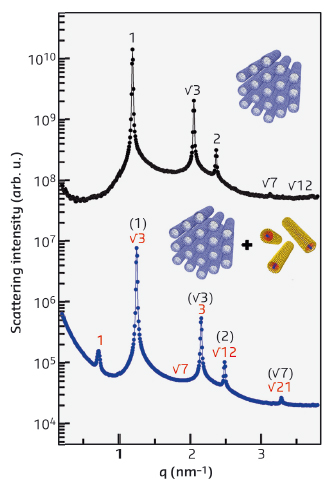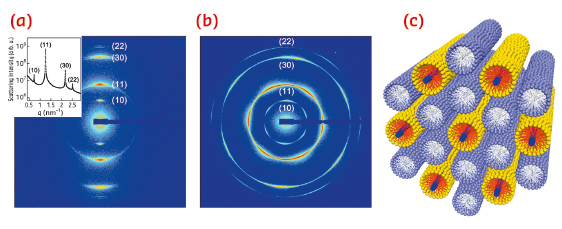- Home
- Users & Science
- Scientific Documentation
- ESRF Highlights
- ESRF Highlights 2014
- Soft condensed matter
- Two-dimensional binary superlattice of a single-walled carbon nanotube/cylindrical-micellar system
Two-dimensional binary superlattice of a single-walled carbon nanotube/cylindrical-micellar system
Binary or multicomponent superstructures of nanoparticles, are of great interest for potential applications such as optical and electronic devices, sensing, and energy storage as well as their own scientific merit [1]. Their synthesis may provide new emerging properties through synergetic coupling between different types of nanoparticles. Exciting progress has been made in the fabrication of binary spherical-nanoparticle superlattices with various symmetries by using an interplay of entropy and van der Waals, electrostatic, and other interactions. However, systematic experimental studies on the formation of binary superlattices by mixtures of two different types of 1-D nanoparticles have been very rare, and the reported structures have been limited to simple liquid-crystalline structures. Here, a highly-ordered and highly-aligned binary superlattice of 1-D nano-objects is demonstrated.
One approach to the synthesis of highly-ordered binary 1-D nanoparticle superlattices is to first find conditions under which 1-D nanoparticles of one type self-assemble into a highly ordered superlattice, and then to add another type of 1-D nanoparticles into the preformed superlattice so that the second type of 1-D nanoparticles can collectively self-assemble with the first type of 1-D nanoparticles. Hydrophilically functionalised single-walled nanotubes (p-SWNTs [2]) with a diameter of 5 nm were added to a solution of the nonionic surfactant C12E5 in water with a fixed C12E5/water mixing ratio (45:55 by weight) at which the C12E5/water solution shows a highly ordered hexagonal phase (hexagonally packed cylindrical micelles with a diameter of 4.44 nm) at low temperature. Small-angle X-ray scattering (SAXS) measurements from the C12E5/water (45:55) and p-SWNT/C12E5/water (10:45:55) systems performed at beamline ID02 (Figure 35) show that a new sharp peak appeared at q = 0.715 nm-1, which has a ratio of 1:√3 with the peak at q = 1.242 nm-1. In fact, all the SAXS peaks of p-SWNT/C12E5/water are directly coupled to each other with specific peak-position ratios (1:√3:2:√7:3:√12:√21). The new scattering peaks in the p-SWNT/C12E5/water system arise from correlations between p-SWNTs, which was confirmed by a contrast-matched small-angle neutron scattering experiment. The coupled peak-position ratios and the origin of new peaks in the SAXS intensity indicate that the mixture forms a highly ordered intercalated hexagonal binary superlattice of p-SWNTs and C12E5 cylinders, in which a hexagonal array of p-SWNTs is embedded in a honeycomb lattice of C12E5 cylinders.
 |
|
Fig. 35: a) Azimuthally averaged SAXS intensities of C12E5/water (45:55, top), p-SWNT/C12E5/water (15:45:55, bottom). |
 |
|
Fig. 36: SAXS Intensities of p-SWNT/C12E5/water aligned by an oscillatory shear, measured along the radial (a) and tangential (b) directions. c) Schematic illustration of the intercalated hexagonal binary superlattice of p-SWNT/C12E5/water. |
To unequivocally identify the structure, we carried out additional SAXS measurements at beamline ID02 for the mixture under an oscillatory shear (Figure 36 a,b). The p-SWNT/C12E5/water loaded in a temperature-controlled shear cell was slowly cooled down from the isotropic phase (30°C) to the intercalated hexagonal phase (19°C) under an oscillatory shear with a shear stress of 500 Pa and an oscillation frequency of 5 Hz. The 2-D SAXS patterns measured along the radial direction are highly anisotropic; all the scattering peaks were found along the direction perpendicular to the flow direction. The 2-D SAXS pattern measured along the tangential direction shows clear six-fold symmetries. These results unarguably confirm that the p-SWNT/C12E5/water indeed forms the intercalated hexagonal binary superlattice (Figure 36c). When p-SWNTs are added to the hexagonally packed C12E5 cylindrical-micellar system, some C12E5 cylinders are replaced with p-SWNTs in such a way that the free-volume entropies for both p-SWNTs and C12E5 cylinders are maximised, resulting in the intercalated hexagonal binary superlattice. The alignment was maintained for more than 24 hours. Although there have been many examples of highly oriented SWNT systems, most of which had no specific symmetry in the cluster of SWNTs, this structure is the first example of a highly oriented SWNT superstructure with hexagonal symmetry. The understanding obtained in this study may provide new insight for engineering highly-ordered binary superlattices of 1-D nanoparticles with new synergetic functionalities such as metallic, semiconducting, and magnetic nanorods, which are of great current interest.
Principal publication and authors
S.-H. Lim (a), H.-S. Jang (a), J.-M. Ha (a), T.-H. Kim (b), P. Kwasniewski (c), T. Narayanan (c), K. S. Jin (d) and S.-M. Choi (a), Angew. Chem. Int. Ed. 53, 12548 (2014).
(a) Department of Nuclear and Quantum Engineering, KAIST (Rep. of Korea)
(b) Korea Atomic Energy Research Institute (Rep. of Korea)
(c) ESRF
(d) University of Science and Technology (Rep. of Korea)
References
[1] J.J. Urban, D.V. Talapin, E.V. Shevchenko, C.R. Kagan and C.B. Murray, Nat. Mater. 6, 115 – 121 (2007).
[2] T.H. Kim, C. Doe, S.R. Kline and S.M. Choi, Adv. Mater. 19, 929 – 933 (2007).



